The ACME Anser was an amphibious twin-jet utility aircraft that was developed in the United States by Air Craft Marine Engineering in 1958. The project was cancelled before the prototype was complete.

The Douglas A2D Skyshark was an American turboprop-powered attack aircraft built by the Douglas Aircraft Company for the United States Navy. The program was substantially delayed by engine reliability problems, and was canceled because more promising jet attack aircraft had entered development and the smaller escort carriers the A2D was intended to utilize were being phased out.

The Yokosuka R2Y Keiun was a prototype reconnaissance aircraft built in Japan late in World War II.

The RWD-10 was a Polish aerobatics sports plane, single-seat parasol wing monoplane, used from 1933 to 1939 and constructed by the RWD team.

The Vega Aircraft Corporation was a subsidiary of the Lockheed Aircraft Company in Burbank, California responsible for much of its parent company's production in World War II.

The Lockheed Altair was a single-engined sport aircraft of the 1930s. It was a development of the Lockheed Sirius with a retractable undercarriage, and was the first Lockheed aircraft and one of the first aircraft designs with a fully retractable undercarriage.

The PZL.44 Wicher (gale) was a prototype of 14-seat, twin-engine Polish airliner, built in the Państwowe Zakłady Lotnicze (PZL) in 1938. It was to compete with the DC-2 and Lockheed Super Electra.

The Air Tractor AT-300 is a family of agricultural aircraft that first flew in the United States on September 1973. Type certification was awarded to Air Tractor in November the same year, and serial production commenced in 1976. Of low-wing monoplane taildragger configuration, they carry a chemical hopper between the engine firewall and the cockpit.

The Cessna Model 411 is an American twin-engined, propeller-driven light aircraft built by Cessna Aircraft. It was that company's largest business aircraft to enter production when it first flew in 1962.

The Arado Ar 76 was a German aircraft of the 1930s, designed as a light fighter with a secondary role as an advanced trainer in mind.

PZL.26 was a Polish sports plane built in 1934 in the PZL works. Ordered by the Ministry of Defence, it was specifically designed for the upcoming Challenge 1934 International Touring Aircraft Contest.

The Funk Model B was a 1930s American two-seat cabin monoplane designed by Howard and Joe Funk. Originally built by the Akron Aircraft Company later renamed Funk Aircraft Company.
The Piper PA-6 Sky Sedan was a 1940s American four-seat light aircraft designed and built in prototype form by Piper Aircraft at its Lock Haven, Pennsylvania, factory.
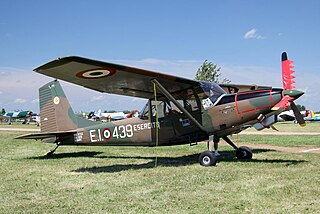
The SIAI-Marchetti SM.1019 is an Italian STOL liaison monoplane built by SIAI-Marchetti for the Italian Army, and based on the Cessna O-1 Bird Dog.
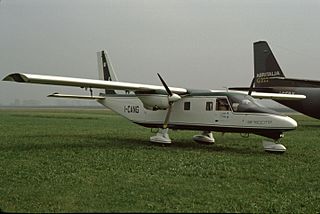
The Vulcanair SF.600 Canguro was a feederliner developed in Italy in the late 1970s. Despite a number of attempts to put the aircraft into series production, only a small number were ever built. The Canguro was a high-wing cantilever monoplane of conventional configuration with a fuselage of rectangular cross-section and a high-set tail. The tricycle undercarriage was not retractable, and its main units were carried on sponsons on the fuselage sides. SIAI Marchetti provided funding towards the construction of the prototype, and constructed this aircraft at the former Aviamilano plant. After flight testing proved positive, the type was put on sale, but failed to attract buyers in any number, even when the original piston engines were exchanged for turboprops and retractable undercarriage was offered as an option.
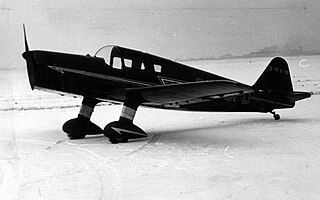
The RWD-19 was a Polish two-seat low-wing sports aircraft of 1938, constructed by the RWD bureau.
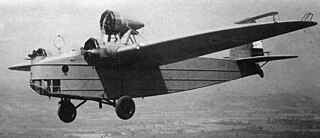
The Dornier Do Y was a German bomber of the 1930s, the second bomber design by Dornier Flugzeugwerke.

The Lockheed L-1649 Starliner was the last model of the Lockheed Constellation line of airliners. Powered by four Wright R-3350 TurboCompound engines, it was built at Lockheed's Burbank, California plant from 1956 to 1958.

The Menasco Unitwin 2-544 was a coupled piston engine. Menasco Motors Company of Burbank, California was a well known manufacturer of inverted inline four and six cylinder engines. At the request of Lockheed Aircraft designers, Menasco produced an inverted twelve-cylinder air cooled aircraft engine by designing a common crankcase and gearbox for two of the six cylinder engines. The two crankshafts were combined with a unique double clutch gearbox to power a single propeller. This gave reliability of a twin engine aircraft in a single powerplant. It was a success, but did not enter production as no aircraft were produced that used it.
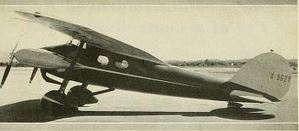
The Alcor Duo-4 was a high wing cabin aircraft, unusually powered by a pair of four cylinder straight engines mounted horizontally either side of the nose. After an accident it was rebuilt with six cylinder engines, becoming the Alcor Duo-6. The name Alcor derived from Allan Lockheed Corporation.



















